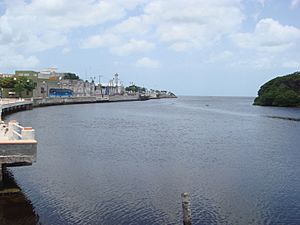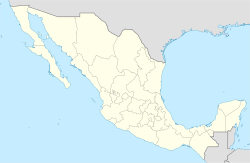Champotón, Campeche facts for kids
Quick facts for kids
Champotón
|
|
|---|---|
|
City
|
|

Champotón at Bay of Campeche
|
|
| Country | |
| State | |
| Municipality | Champotón |
| City Founded | 1538 |
| Elevation | 10 m (30 ft) |
| Population
(2010)
|
|
| • Total | 30,881 |
| • Demonym | Champotonero |
| Time zone | UTC−6 (CST) |
| • Summer (DST) | UTC−5 (CDT) |
| Area code(s) | 982 |
| Website | http://www.champoton.gob.mx/ |
Champotón is a small city in the Mexican state of Campeche. It is located about 60 kilometers south of the city of Campeche. The small Champotón river meets the Gulf of Mexico here. In 2010, about 30,881 people lived in Champotón.
Long ago, Champotón was known by names like Chakanputun and Chanpaton. It was an important city for the Maya civilization over 1,000 years ago. In the 1500s, Spanish explorers arrived. A famous battle called "Mala Pelea" (which means "Bad Fight") happened here. The Maya people bravely fought off the first Spanish explorers.
Contents
History of Champotón
Ancient Maya History
The Itzáes, a Maya group, arrived in the Yucatán peninsula around the year 435. They settled in places like Chakán Putum, which is now Champotón. Later, around 869, another Maya group called the Tutul Xiúes came. They made the Itzáes leave Chakán Putum. The Tutul Xiúes mainly settled in a city called Uxmal.
Over time, different Maya groups formed alliances. The Cocomes, Itzáes, and Tutul Xiúes created the Mayapán League in 1047. But these groups eventually fought each other. This led to the league breaking apart in 1441. After this, the Yucatán Peninsula was divided into many smaller Maya areas. Champotón was part of one of these areas.
First Spanish Encounters
In 1517, the first Spanish expedition reached the Mexican coast. It was led by Francisco Hernández de Córdoba. They landed in Campeche first, then sailed south to Champotón. They needed water, but they made a mistake by not closing their water containers.
When they landed in Champotón, they met many Maya warriors. The Maya attacked the Spanish fiercely. More than 50 Spanish soldiers were killed, and their captain, Hernández de Córdoba, was badly wounded. The Maya even shouted "calachuni," meaning "the boss," to target him. The Spanish had to quickly leave without enough water. They fled to Florida and then back to Cuba. Hernández de Córdoba died soon after from his injuries. Because of this tough battle, Champotón was called "Puerto de Mala Pelea" or "Port of the Bad Fight." A Maya chief named Moch led the Maya to this first victory against a foreign army in America.
Later Spanish Expeditions
The next year, in 1518, another Spanish expedition arrived. This one was led by Juan de Grijalva. They were better prepared for a fight. They also came to Champotón for water. There was another battle, and this time the Spanish won. However, they still had casualties and many wounded. The Maya suffered many losses, and their chief died.
Grijalva tried to talk to other Maya leaders, but no one came. So, his expedition left Champotón and continued exploring the coast. Hernán Cortés led the third Spanish expedition in 1519. He wanted to land in Champotón to get revenge for the earlier defeats. But strong winds prevented his ships from landing. He sailed past Champotón and later fought the Maya in another area.
Spanish Conquest of Yucatán
In 1526, Francisco de Montejo received permission from the Spanish king to conquer the Yucatán Peninsula. The conquest of Champotón and Campeche was part of this big effort. It happened in three main stages.
Montejo's first attempt (1527-1529) in the northeast was stopped by the Maya. His second attempt (1530-1535) focused on the west. In 1531, he founded "Salamanca de Campeche." But the Maya fought back strongly. In 1535, the Spanish had to leave the peninsula completely.
Later, Montejo ordered his son and nephew to try again. In 1538, the Spanish established a settlement in Champotón. They called it "Villa de San Pedro Champotón." At first, the Maya in Champotón cooperated. But when they saw how few Spanish soldiers there were, they planned to rebel. Montejo's nephew found out and captured the Maya leaders. This made them promise to obey the Spanish. The town's name was changed to "Salamanca de Champotón."
In 1540, more Spanish resources arrived. A garrison was set up in San Francisco de Campeche. The conquest of Yucatán continued north. In 1543, a bishop was appointed for the region, which included Champotón. Franciscan friars also arrived in 1546 to spread Christianity. That same year, Francisco de Montejo introduced sugarcane farming to the area.
Champotón Through the Centuries
During the time of the Viceroyalty (when Spain ruled Mexico), Champotón became an important sugar-producing region. The city had people of Spanish, Maya, and African descent. English pirates attacked Champotón several times in the 1600s and 1700s, causing a lot of damage.
When Mexico gained independence from Spain, it was a peaceful process in Champotón. During the Caste War of Yucatán (a major conflict between Maya people and others), Champotón was a safe place. Many people from other parts of the peninsula found refuge here. In 1852, Champotón was officially made a village. When Campeche became a state, Champotón became part of it.
In 1863, French forces landed in Champotón and attacked a fort. But the local Mexican troops, led by Colonel Pedro Celestino Brito, bravely fought back. They managed to take back the fort and make the French retreat to their ships.
The Mexican Revolution (1910-1920) did not greatly affect Champotón. In 1957, Champotón was officially given the title of a city. Later, in 2014, it was declared the "Heroic City of Champotón" to honor its brave history.
Population
As of 2010, the city of Champotón had a population of 30,881 people.
Geography
Climate
Champotón has a warm climate. Here is some information about its weather:
| Climate data for Champotón (1951–2010) | |||||||||||||
|---|---|---|---|---|---|---|---|---|---|---|---|---|---|
| Month | Jan | Feb | Mar | Apr | May | Jun | Jul | Aug | Sep | Oct | Nov | Dec | Year |
| Record high °C (°F) | 36.0 (96.8) |
37.0 (98.6) |
41.0 (105.8) |
42.0 (107.6) |
42.0 (107.6) |
42.0 (107.6) |
39.0 (102.2) |
38.0 (100.4) |
37.0 (98.6) |
36.0 (96.8) |
35.0 (95.0) |
36.0 (96.8) |
42.0 (107.6) |
| Mean daily maximum °C (°F) | 28.6 (83.5) |
30.2 (86.4) |
31.9 (89.4) |
34.4 (93.9) |
35.2 (95.4) |
34.2 (93.6) |
33.8 (92.8) |
33.1 (91.6) |
32.5 (90.5) |
31.1 (88.0) |
29.7 (85.5) |
28.7 (83.7) |
32.0 (89.6) |
| Daily mean °C (°F) | 22.6 (72.7) |
23.7 (74.7) |
25.1 (77.2) |
27.5 (81.5) |
28.6 (83.5) |
28.2 (82.8) |
27.7 (81.9) |
27.4 (81.3) |
27.2 (81.0) |
25.9 (78.6) |
24.3 (75.7) |
22.9 (73.2) |
25.9 (78.6) |
| Mean daily minimum °C (°F) | 16.6 (61.9) |
17.3 (63.1) |
18.3 (64.9) |
20.5 (68.9) |
22.0 (71.6) |
22.3 (72.1) |
21.7 (71.1) |
21.7 (71.1) |
22.0 (71.6) |
20.8 (69.4) |
18.8 (65.8) |
17.1 (62.8) |
19.9 (67.8) |
| Record low °C (°F) | 8.0 (46.4) |
8.0 (46.4) |
8.0 (46.4) |
11.0 (51.8) |
14.0 (57.2) |
18.0 (64.4) |
18.0 (64.4) |
18.0 (64.4) |
19.0 (66.2) |
12.0 (53.6) |
12.0 (53.6) |
8.0 (46.4) |
8.0 (46.4) |
| Average precipitation mm (inches) | 25.2 (0.99) |
25.8 (1.02) |
16.1 (0.63) |
12.0 (0.47) |
59.7 (2.35) |
220.9 (8.70) |
201.1 (7.92) |
226.8 (8.93) |
246.5 (9.70) |
153.3 (6.04) |
61.7 (2.43) |
33.1 (1.30) |
1,282.2 (50.48) |
| Average precipitation days (≥ 0.1 mm) | 3.5 | 2.4 | 2.0 | 1.3 | 3.9 | 13.6 | 14.1 | 15.9 | 14.7 | 10.0 | 4.4 | 3.5 | 89.3 |
| Source: Servicio Meteorológico National | |||||||||||||
See also
 In Spanish: Champotón para niños
In Spanish: Champotón para niños


